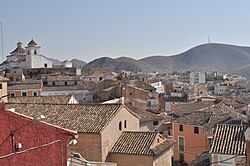| Hellín | |
|---|---|
| Municipality | |
 | |
 Flag Flag Coat of arms Coat of arms | |
   | |
| Coordinates: 38°31′0″N 1°41′00″W / 38.51667°N 1.68333°W / 38.51667; -1.68333 | |
| Country | Spain |
| Autonomous community | Castilla–La Mancha |
| Province | Albacete |
| Government | |
| • Mayor | Ramón García Rodríguez (PSOE-CLM) |
| Area | |
| • Total | 781.66 km (301.80 sq mi) |
| Elevation | 555 m (1,821 ft) |
| Population | |
| • Total | 30,268 |
| • Density | 39/km (100/sq mi) |
| Demonym | Hellineros or Ilunenses |
| Time zone | UTC+1 (CET) |
| • Summer (DST) | UTC+2 (CEST) |
| Postal code | 02400 |
| Website | Official website |
Hellín is a city and municipality of Spain located in the province of Albacete, Castilla–La Mancha. The municipality spans across a total area of 781.66 km. As of 1 January 2020, it has a population of 30,200, which makes it the second largest municipality in the province. It belongs to the comarca of Campos de Hellín.
History
There is an archaeological site at Tolmo de Minateda hill near Hellín, with phases of Iberian, Roman and Visigoth occupation. There are archaeological evidences suggesting that the Minateda site may have stood at some point at the Byzantine side of the limes. A tentative identification with the Iyih mentioned in the Pact of Theodemir has been also proposed. Minateda was thus probably known as Madinat Iyyuh during the Islamic period. The Arabic name of Hellín was however Falyān, which eventually evolved into 'Felín', and then 'Hellín'.
The importance of the Sulfur-rich mining district in the south of the municipality led to the creation of a mining community in the area (Las Minas), that became a leading producer of sulfur in southwestern Europe during the 18th and 19th centuries.
Railway arrived to the town in 1864, with the opening of the Chinchilla–Hellín stretch on 18 January and the Hellín–Agramón [es] stretch on 8 October.
See also: Chinchilla–Cartagena railwayHellín was granted the title of city (ciudad) in 1898. Esparto cultivation increased in the first decades of the 20th century, peaking in importance during the Autarky period of the Francoist dictatorship, with the expansion of irrigated crops.
Culture
Main celebrations, such as the processions and the traditional tamborada (drumming), declared of international tourist interest, occur during the Holy Week (in Spanish, Semana Santa).
Main sights
Notable people
- Maria Baldó i Massanet (1884–1964), teacher, feminist, folklorist, and liberal politician
- Ginés de Boluda, composer
- Juan Carlos Izpisua Belmonte, biochemist & pharmacologist
- Josico, footballer
- Manuel Castells, sociologist
Twinned cities
- Paysandú, Uruguay
References
- Citations
- Municipal Register of Spain 2018. National Statistics Institute.
- ^ "Datos del Registro de Entidades Locales". Ministerio de Asuntos Económicos y Transformación Digital. Retrieved 26 May 2021.
- Abad Casal, Gamo Parras & Gutiérrez Lloret 2004, pp. 145–150.
- Abad Casal & Gutiérrez Lloret 1997, p. 591.
- Abad Casal & Gutiérrez Lloret 1997, p. 592.
- ^ Abad Casal, Gamo Parras & Gutiérrez Lloret 2004, p. 160.
- Romera Tébar 2018, pp. 359–360.
- Mirón López 2018, p. 18.
- Losada Azorín 2002, p. 147.
- Losada Azorín 2002, pp. 150, 158.
- Bibliography
- Abad Casal, Lorenzo; Gutiérrez Lloret, Sonia (1997). "Iyih (El Tolmo de Minateda, Hellín, Albacete): Una Civitas en el Limes visigodo - bizantina". Antigüedad y Cristianismo. Revista de estudios sobre Antigüedad Tardía (14). Murcia: University of Murcia. ISSN 0214-7165.
- Abad Casal, Lorenzo; Gamo Parras, Blanca; Gutiérrez Lloret, Sonia (2004). "El Tolmo de Minateda, Hellín (Albacete)". Investigaciones arqueológicas en Castilla La Mancha : 1996-2002 (PDF). Junta de Comunidades de Castilla-La Mancha. ISBN 84-7788-332-7.
- Losada Azorín, Alfredo Antonio (2002). "La evolución en la población hellinera desde 1875 a 1950". In Panadero Moya, Carlos; Requena Gallego, Manuel (eds.). II Congreso de Historia de Albacete: del 22 al 25 de noviembre de 2000 (PDF). Vol. 4. pp. 147–159. ISBN 84-95394-43-X.
- Mirón López, Manuel (2018). "La Línea Albacete-Cartagena (IV). Duelo de marqueses" (PDF). Arriate. Revista Oficial de la Demarcación de Murcia del Colegio de Ingenieros de Caminos, Canales y Puertos (39): 15–19. ISSN 2386-4044.
- Romera Tébar, Cristina (2018). "Valorización de la antigua industria minera del azufre y sus múltiples dimensiones patrimoniales". In Cutillas Orgilés, Ernesto (ed.). Convergencia y transversalidad en humanidades. Actas de las VII Jornadas de Investigación de la Facultad de Filosofía y Letras de la Universidad de Alicante (Alicante, 6 y 7 de abril de 2017) (PDF). Alicante: Universidad de Alicante. pp. 359–366. ISBN 978-84-948233-2-9.
External links
- "Hellín" . Encyclopædia Britannica. Vol. 13 (11th ed.). 1911.
- Official website
- Web oficial de Turismo de Hellín